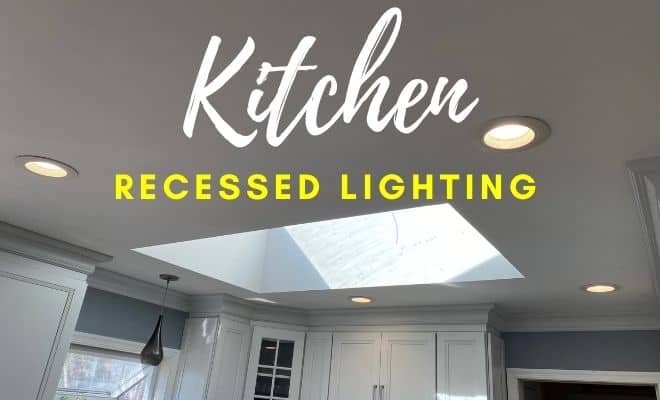Last Updated on August 19, 2022 by The Tutor
Guide to Kitchen Recessed Lighting

Recessed lights are a type of lighting fixture that is installed directly into a hollow opening inside a ceiling. The light from a recessed lighting fixture illuminates in a downward direction and appears to shine from a hole in the ceiling.
Recessed lighting in the kitchen provides a sleek, classy, and clean look that can illuminate a space with a warm and inviting ambiance while also providing enough lighting for cooking and entertaining.
Is Recessed Lighting Good for a Kitchen?
Kitchen lights should be well-planned and you need enough illumination to help you work efficiently and the lighting fixture should also provide a welcoming feel.
With its downlight appearance, using recessed lighting in a kitchen can help you accomplish specific kitchen tasks like food preparation and cooking while illuminating the entire area. Recessed lights can also create mood lighting effects. In general, recessed lighting in a kitchen is an ideal option if you want to combine aesthetics with functionality.
Kitchen recessed lighting offers a clean and minimalist appearance and can be used for the entire kitchen space—including countertops, island bars, cooking area, sink, and even the open floor plan area. Depending on the type of kitchen and cabinets you have, you can use kitchen recessed lights with or without other lighting fixtures, such as the standard flush mount ceiling lights or pendant lights.
How Many Recessed Lights are Ideal in a Kitchen?
Having too many or two few recessed lights is one of the most common mistakes in using kitchen recessed lighting. The number of recessed lights to use will depend on how big your kitchen space is, the natural lighting available, and your personal preference. You should also consider the height of your ceiling and other factors such as the type of lighting used and if you will use other lighting fixtures to illuminate walls and under-cabinet spaces.
Ideally, you should use one recessed light for every 15-25 square feet of ceiling space to provide even illumination to your entire kitchen area. However, this will still depend on the quantity of lighting you prefer and if you are relying exclusively on recessed ceiling lights or using other lighting fixtures. Consider how much illumination you will need, especially during nighttime when there is no more natural light.
The following steps will help you calculate how many recessed lights you’ll need for your kitchen:
- Measure the entire kitchen space’s square footage.
- Find out the total wattage/lumens needed for the entire kitchen space by multiplying the kitchen’s square footage by 1.5.
- Choose your preferred recessed light bulbs and take note of the wattage/lumens per bulb.
- To know the number of recessed light bulbs that you’ll need, divide the total wattage/lumens needed for the entire kitchen space by your chosen bulb’s wattage/lumens, as follows:
Total wattage or lumens for the entire kitchen space ÷ wattage or lumens per bulb = Number of lights needed
Recessed Lighting in a Small Kitchen
For a small kitchen, six recessed lights are typically enough in two rows of three along the length of the kitchen space. For recessed lights placed in a perimeter near the edge of the ceiling, a total of eight to 10 recessed lights will be sufficient. However, the exact number of lights you may need will depend on the actual size and shape of your kitchen.
Placement of Recessed Lighting in a Kitchen
Kitchen recessed lighting needs to be spaced out properly so that the light spreads across the area evenly. Spacing your recessed lights correctly is important if you don’t want your kitchen to look too dim or too bright. While there are basic kitchen lighting plans, the exact placement of lights will depend on your unique room space.
The general rule is to divide the height of your ceiling by two when spacing your recessed lights. For instance, if your ceiling height is 8 feet, you can space recessed lights about 4 feet apart.
There are two ways to arrange your recessed lighting in your kitchen:
1.Arrange the lights in two parallel rows.
Visualize a line running straight through the center of your ceiling, which will divide the ceiling into two equal halves. Then imagine another line running through the center of each half—these are the parallel rows where you should position your recessed lights.
2.Arrange the lights along a perimeter trailing the edge of the ceiling.
Placing the lights around the perimeter of the room is perfect if you have a drop lighting fixture at the center of your kitchen. The perimeter should ideally be about 3 feet from the edge of the ceiling.
To light counter areas, recessed lights should be placed around 12 inches to 18 inches away from any cabinets. Kitchen recessed lights that are intended for task lighting should be directly positioned over the edge of the countertop, around 24 inches away from the wall. This placement directs the beam right over the work surface and avoids unnecessary shadows. The recessed light placement should prevent any person’s body from blocking the light when working at the counter. When done this way, it also throws light directly into open drawers.
Read more about How to layout recessed lighting
Kitchen Recessed Lighting Tips
The kitchen is a very unique and special room in your home. It is a place where people gather to relax and also a room where you are trying to accomplish specific tasks. Therefore, the lighting in the kitchen will not only be different than your family room for example, but you may need three different types of lighting for each area of the kitchen.
The first tip is to section off your kitchen in to areas where there may be a need for specific types of lighting. You may have an area where the table will be, then the counters, over the sink and also ambient lighting for the entire room in general. So, understand what type of lighting you need for each area.
The next tip is to go the extra mile by wiring each section of your kitchen so they can be controlled by an independent switch. For example, the light over your sink should be controlled by its own switch. Same for the lighting over your kitchen table, the lights over the working area of your kitchen, your pendants over the island, and one for the under cabinet lights.
Finally, determining how many lumens and what color temperature you will need is absolutely critical.
Alternatives to Recessed Lighting in a Kitchen
Recessed lighting is one of the most common options for modern kitchen spaces. It can help fill the gaps for general kitchen lighting. If you think kitchen recessed lighting is not ideal for your home design, consider these kitchen lighting alternatives:
- Flush Mounts: Ceiling flush mounts are ideal for decorative kitchen lighting. This type of lighting adds just the right amount of ambient lighting to your kitchen. Flush mounts can also take the place of a chandelier, especially for kitchens with lower ceilings.
- Chandeliers and Kitchen Pendant Lights: Small chandeliers and pendant lightings are two of the most popular options for kitchen lighting. These are typically used for kitchen island bars, while some smaller pendant lights are used for working spaces. Bigger pendants can be used as a visual centerpiece.
- Linear and Multi-light Suspensions: Linear suspensions and multi-light suspensions are typically installed over a kitchen island bar, breakfast nooks, and countertops. Ideally, they should be installed at least 30 inches from the countertop, so as not to create a divider in the middle of the island bar.
Read more about How to Light a Kitchen
Kitchen Recessed Lighting Fixtures
When it comes time to buying recessed lights for your kitchen, you will have many options. You can install cans in the ceiling that are made for remodeling purposes. You can also go with some newer types of recessed lighting that have the wiring and housing all contained into a compact unit. Then, you just cut the hole, attach the wire, and the recessed light will just clip to the drywall in the ceiling.
There are some recessed lighting fixtures that come with the LED bulb included and enclosed without the ability to change the bulb. Therefore, you need to decide how many lumens you need from the fixture and what color temperature you want before shopping for recessed lights.
The recessed lighting fixtures in the kitchen area there to provide light. They should not be considered to be ornamental like a pendant light. Therefore, they should not draw attention at all when deciding which trim to purchase.
See our Recommendations for Recessed Lighting
Final Touches
Whatever type of kitchen lighting you choose, it’s important to ensure that the entire kitchen space is illuminated evenly and that you don’t miss a pathway or under-cabinet area. You may also need to consider using another type of kitchen lighting, like a centerpiece pendant, with your recessed lights. Talk to a professional electrician and designer and discuss what’s best for lighting your unique space according to your preference.
